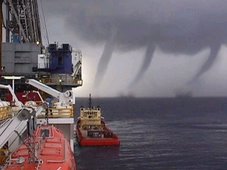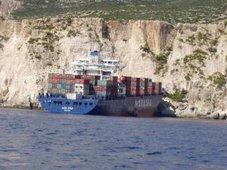ScienceDaily (June 14, 2008) — This year may set records for tornadoes and tornado-related deaths. “We have already seen more than 115 tornado-related deaths, making this the deadliest tornado season since 1998,” said Greg Carbin, a meteorologist at NOAA’s Storm Prediction Center in Norman, Okla.
“It is only the third time since the 1974 super tornado outbreak that there have been more than 100 tornado-related deaths during a single tornado season in the U.S.,” added Harold Brooks, a research meteorologist at NOAA’s National Severe Storms Laboratory also in Norman. “In 1998 and 1984 there were 132 and 122 tornado-related deaths, respectively — 2008 will likely equal or exceed that record.”
Recent years averaged about 1,200 tornadoes and 60 tornado-related deaths reported annually across the United States. Most tornadoes occur from late winter to mid-summer, mostly in the Southeast in the early part of the season, followed by the Midwestern and Plains states in the later part of the season.
So why has this tornado season been so active? Meteorologists at NOAA’s Storm Prediction Center say this winter's and early spring’s unusually turbulent weather may be to blame.
"The storm track over the last three months was very active across the Rockies and into the East Coast. This active storm track lends itself to more severe weather events, including tornadoes," said Carbin. “In previous years, major storms happened every week or so, but we have had a major storm system affecting some part of the U.S. every three to four days through early spring.”
“Another contributing factor is this year’s early start to the season. A total of 87 tornadoes struck the Tennessee valley and Midwest over a 24 hour period starting on Feb. 5, resulting in a total of 56 deaths,” said Carbin. “This storm ranks as number 15 in terms of the number of fatalities since 1950. February will likely turn out to be a record setting month once all the tornado reports have been verified.”
The tornadoes this season are also touching down in highly populated areas, thus increasing both the number of fatalities and the number of eyewitness reports of each tornado.
The strong start to the tornado season should serve as a reminder to us all that tornadoes can strike anywhere at any time. The best defense is to monitor the news and listen to NOAA Weather Radio All Hazards for the latest weather updates. Be prepared to move to safety if weather conditions become threatening.
The National Oceanic and Atmospheric Administration, an agency of the U.S. Commerce Department, is dedicated to enhancing economic security and national safety through the prediction and research of weather and climate-related events and information service delivery for transportation, and by providing environmental stewardship of our nation's coastal and marine resources. Through the emerging Global Earth Observation System of Systems (GEOSS), NOAA is working with its federal partners, more than 70 countries and the European Commission to develop a global monitoring network that is as integrated as the planet it observes, predicts and protects.
WEATHER NOTE
NOAA: New Orleans at risk from Cat. 2 hurricane
Tuesday June 17, 1:34 pm ET
By Cain Burdeau, Associated Press Writer
While the forecast uses what officials say is the most accurate and complete picture yet of the region's levee heights, they said they weren't surprised by findings that reaffirm the area surrounding New Orleans is among the nation's most hurricane-vulnerable. The forecast released Monday represents the first time the yearly storm surge predictions have used levee heights based on global positioning system technology.
A team led by Roy Dokka, the director of the Center for Geoinformatics at Louisiana State University, traveled 1,000 miles of levees, flood walls and other coastal features since Katrina with GPS technology mounted on vehicles to obtain the new measurements.
"They are more correct than they have ever been before," Wilson Shaffer, a hurricane modeling expert with NOAA's National Weather Service, said of the levee-height measurements.
To predict how strong a storm would be to overpower a levee, researchers factor in variables including topography and a storm's wind speeds, size and intensity. The projections on storm surge are used by emergency planners, builders, residents and the Army Corps of Engineers.
The Corps of Engineers is determining how high to build levees under a congressional mandate to complete by 2011 a hurricane protection system capable of handling a storm likely to hit over the next century. A strong Category 2 likely would fall under that definition.
On Monday, the corps was unable to provide a breakdown on how much has been spent so far on work to repel storm surge. Since Katrina, Congress has given the corps about $7.1 billion to work with and it is considering giving the corps $5.7 billion more.
"We have a long way to go," said Randy Cephus, a corps spokesman in New Orleans. "There still remains risk and even once the system is complete, there will always be risk."
Before Katrina hit nearly three years ago, levee heights were woefully out-of-date and in many places far lower than officials thought they were, Dokka said.
But, unfortunately, the new measurements, incorporating post-Katrina levee upgrades, confirm an old story: the region remains at risk.
"In general, the pattern hasn't changed remarkably," said Stephen Baig, a storm surge expert with NOAA's National Hurricane Center. "Somewhere between a Category 2 and Category 3 overtopping occurs."
The NOAA storm surge estimates do not take into consideration possible engineering failures, like the levee breaches that caused most of the misery in New Orleans during Katrina, which was a category 3 upon landfall south of New Orleans.
State officials were not surprised by the latest findings.
"All of coastal Louisiana is vulnerable and will continue to be vulnerable," said Jerome Zeringue, a top levee aide to Gov. Bobby Jindal.
MARITIME NOTE
U.S. Coast Guard Maritime Safety Proposals
On March 31, 2008, the Department of Homeland Security posted an Advanced Notice of Proposed Rulemaking (ANPR) that has the potential to impact certain commercial fishing vessels. The Coast Guard is developing a set of proposed amendments to enhance maritime safety through changes to commercial fishing industry vessel regulations. The proposed changes would add new requirements for vessel stability and watertight integrity, stability training and assessments, vessel maintenance and self-examinations, immersion suits, crew preparedness, safety training, emergency preparation, safety and training personnel, safety equipment, and documentation. Miscellaneous conforming, clarifying, and other administrative changes are also contemplated.
To view the ANPR visit http://www.regulations.gov (In the search box type in USCG-2003-16158 proposed rule). You can also secure a copy of the ANPR by: visiting the Mid-Atlantic Fishery Management Council's website at http://www.mafmc.org; requesting a copy of the ANPR from the Council by calling (302) 674-2331; or, emailing the Council at info@mafmc.org.
Following is the list of the 30 questions included at the end of the Federal Register Notice to which the Coast Guard is requesting public response.
1. Given the statistics on vessel losses in Tables 2 and 3, what issues related to stability and watertight integrity should the Coast Guard consider addressing in regulations?
2. Table 2 shows that vessel flooding results in the most vessel losses, and Table 3 shows that flooding and sinking account for a significant portion of fatalities. What areas should be addressed to reduce vessel flooding losses and fatalities?
3. What routine measures are used to prevent unintentional flooding?
4. How often is your vessel examined by a marine surveyor and under what circumstances? Is documentation of the survey provided?
5. Table 3 shows that fire is a significant cause of vessel losses. What areas should the Coast Guard consider addressing to reduce the number of fire related vessel losses (including, but not limited to: construction standards, detection and extinguishing equipment, fire fighting equipment, and firefighting training)?
6. What means are used to limit the danger of fires and the consequence of fires?
7. Table 2 shows that a significant number of vessel losses are related to allisions, collisions, and groundings; how should the Coast Guard address these causes of vessel losses?
8. What impact has safety training had in improving safety within the commercial fishing industry? Do you have recommendations concerning safety training?
9. What impact has crew drills had in improving safety within the commercial fishing industry? Do you have recommendations concerning crew drills?
10. If training were required would it be accomplished during off-season times?
11. How would additional training impact one’s ability to fish?
12. If stability standards for vessels between 50 feet and 79 feet in length are considered, what standards should apply, and to which vessels should the standards apply?
13. How does a crew become experienced in safety procedures?
14. Should entry level crewmembers be expected to have a minimum level of familiarity with safety procedures?
15. How and when is stability guidance used? If stability guidance is available but not used, please explain why.
16. How are operating personnel made aware of stability and watertight integrity guidance?
17. How often should stability guidance be reviewed, updated, or validated?
18. How are modifications to a vessel or its gear accounted for relative to the vessel’s maximum load, watertight integrity, and other stability considerations?
19. How adequate are current requirements for personal protection and survival equipment?
20. How do crew members become familiar with vessel safety and survival equipment?
21. How are safety risks aboard your vessel(s) identified and minimized?
22. If you are a small business, what economic impact on you, your business, or your organization would the rules we are considering have? In your comments please explain why, how, and to what degree such rules would have an economic impact.
23. Have you experienced—or are you aware of—any situations where any of the measures under consideration saved lives, or prevented/reduced harm/damage to vessels?
24. Are there areas not addressed that would benefit safety within the commercial fishing industry?
25. What are the costs of each requirement we are considering? Are there comparable alternative solutions to each requirement under consideration that may be more cost effective?
26. What are the direct and indirect costs of each requirement we are considering? For example, labor costs, training costs, and hourly wages of fishermen (or alternative measures of valuing their time if they are not salaried)? The costs of vessel losses, including equipment, lost catches, and any other opportunity costs?
27. Can any of the requirements we are considering be completed offseason? If so, which ones? For those that cannot, how much time would be taken away from productive fishing time to complete the requirement? How would this affect revenue, i.e., fish catches?
28. What would be the impact on the domestic fishing industry, if any, of each requirement we are considering? Would there be a differential impact by size of vessel or region?
29. What would be the economic impact of each requirement we are considering on States, local, and tribal governments?
30. What other requirements, if any, should the Coast Guard be considering?
Comments and related material must reach the Docket Management Facility on or before July 29, 2008. You may submit comments identified by Coast Guard docket number USCG-2003-16158 to the Docket Management Facility at the U.S. Department of Transportation. To avoid duplication, please use only one of the following methods:
(1) Online: http://www.regulations.gov.
(2) Mail: Docket Management Facility (M-30), U.S. Department of Transportation, West Building Ground Floor, Room W12-140, 1200 New Jersey Avenue SE., Washington, DC 20590.
(3) Fax: 202-493-2251.
(4) Hand deliver: Room W12-140 on the Ground Floor of the
If you have questions on the proposed rule, call M.M. Rosecrans, Chief, Fishing Vessel Safety Division (CG-
***This press release will be available on our website in a downloadable PDF format in the coming days. Please visit:
RS

















![Validate my RSS feed [Valid RSS]](valid-rss.png)
No comments:
Post a Comment